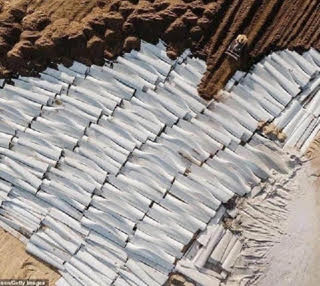By: Dan Nebert – March 28, 2022
That little yellow thing at the top of the picture is a CAT-9 bulldozer. It is burying acres and acres of windmill blades used for “Green Energy.” Why?
Because these blades need to be disposed of, and there is presently no way to recycle them. That’s how green energy works! Who knew? Maybe the people that make them knew. Why would they let that cat out of the bag? After all, they are government-subsidized with tax-payer money (just like every electric car). Also, politicians do not want those huge eyesores in their backyard.
Right now, the average wind farm contains about 150 turbines. Each wind turbine needs 80 gallons of oil as a lubricant, and we’re not talking about vegetable oil, this is a PAO synthetic oil based on crude. 12,000 gallons of it for 150 turbines, and that oil needs to be replaced once a year. It is estimated that a little over 3,800 turbines would be needed to power a city the size of New York… That’s 304,000 gallons of refined oil per year for just one city. That’s 25+ wind farms.
Now, you have to calculate every city across the nation, large and small, to find the grand total of yearly oil consumption from “clean” energy. Where do you think all that oil is going to come from? Well, since January 2021, it comes from our enemies in the Mideast. Not to mention the fact that the large equipment needed to build these wind farms runs on petroleum. As well as the equipment required for installation, service, maintenance, and eventual removal. And just exactly how eco-friendly is wind energy anyway?
Each turbine requires a footprint of 1.5 acres, so a wind farm of 150 turbines needs 225 acres. To power a city the size of NYC, you’d need 57,000 acres; and who knows the astronomical amount of land you would need to power the entire US. All of which would have to be clear-cut land because trees create a barrier and turbulence that interferes with the 20mph sustained wind velocity necessary for the turbine to work properly. Also, keep in mind that not all states are suitable for such sustained winds. Boy, cutting down all those trees is gonna upset a lot of green-loving tree-huggers.
Let’s now talk about disposal.
The lifespan of a modern, top-quality, highly efficient wind turbine is 20 years. After that, what happens to those gigantic fiber composite blades? They cannot be economically reused, refurbished, reduced, repurposed, or recycled. So, it’s off to special landfills they go. And, they’re already running out of these special landfill spaces for the used blades that have already exceeded their usefulness. Those blades are anywhere from 120 ft. to over 200 ft. long, and there are 3 per turbine. And that’s with only 3% to 7% of the nation currently being supplied with (intermittent, i.e., unreliable) wind energy. Just imagine if we had the other 93% of the nation on the wind grid… 20 years from now you’d have all those unusable blades with no place to put them… Then 20 years after that, and 20 years after that, and so on. “Green energy?”
Also, about 500,000 birds are killed each year from wind turbine blade collisions, many of which are endangered hawks, falcons, owls, geese, ducks, and eagles. Apparently, smaller birds are more agile and able to dart and dodge out of the way of the spinning blades, whereas the larger soaring birds aren’t so lucky.
Here’s another problem with windmills. The generator and switching equipment operate at high power and voltage. Everything in the windmill nacelle (look it up) is compact due to limited space, so there’s a danger of arcs and electrical fires. This is prevented by putting all the electrical equipment in a pressure vessel filled with sulfur hexafluoride (SF6), a synthetic gas that has dielectric properties which suppress arcs and fires. However, windmills leak this gas, something around a pound each per year. SF6 has an atmospheric lifetime of 3,200 years and is 22,800 times more effective as a greenhouse gas than carbon.
Daniel (“Dan”) Walter Nebert is an American physician-scientist, molecular biologist, and geneticist. He has authored/coauthored publications in fields of biochemistry, molecular biology, pediatrics, developmental biology, pharmacology, drug metabolism, toxicology, mouse genetics, human genetics, evolutionary genomics, gene nomenclature, and cancer.


Putin always looks dead. He has the most expressionless face I ever saw. But my wife, a former Russian national, says that is the way he was trained by the KBG…no expression, nobody is as likely to remember him.
Leftist hypocrisy reigns supreme.